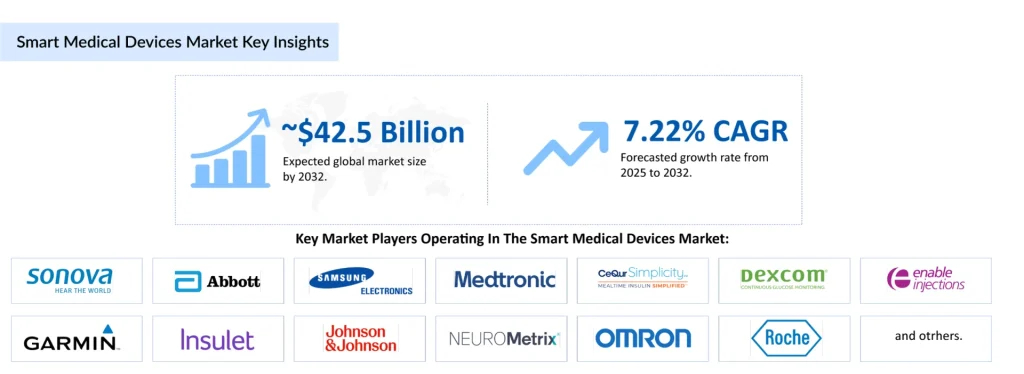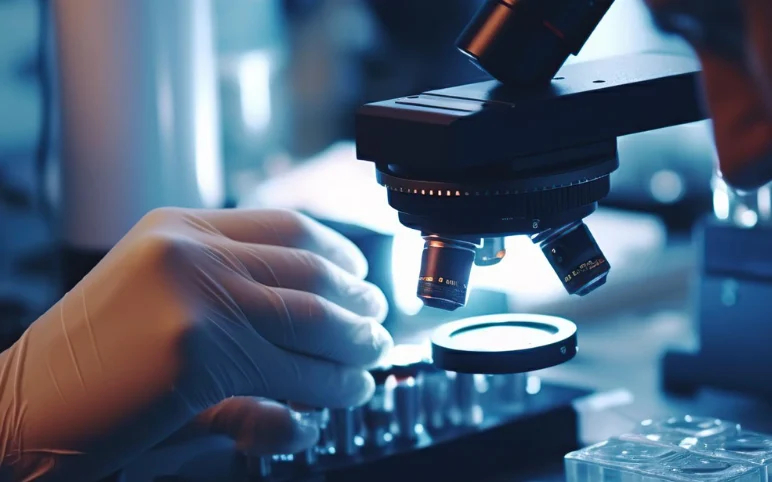The Revolution of Healthcare: Smart Medical Devices Transforming the Future
Aug 27, 2025
Table of Contents
The global healthcare landscape is witnessing a seismic shift, propelled by the rapid integration of smart healthcare technology into everyday medical practice. At the forefront of this transformation are smart medical devices are intelligent tools that combine advanced sensors, wireless connectivity, data analytics, and artificial intelligence to deliver real-time insights, personalized care, and improved health outcomes. These innovations are not only enhancing diagnostic accuracy and treatment precision but are also empowering patients to take control of their health like never before.
The smart medical devices market is growing rapidly, driven by increasing demand for healthcare smart devices that enhance diagnostics, improve treatment precision, and empower patients with greater control over their health. From wearable health trackers to connected inhalers and AI-powered diagnostic platforms, smart devices in healthcare are bridging the gap between traditional medical practices and the needs of a data-driven, patient-centric world.
Downloads
Click Here To Get the Article in PDF
Recent Articles
- How is Artificial Intelligence Used in Drug Discovery & Development?
- Notizia
- Nexalin Technology Secures Israeli Regulatory Clearance for Gen-2 SYNC 15 mA DIFS™ Neurostimulati...
- Nanobots in Medicine: Transforming Healthcare from the Inside Out
- Olympus Launches New Gynecologic Power Morcellator; Journey Biosciences Launched NaviDKD; GE Boar...
What Are Smart Medical Devices?
Smart medical devices, also known as intelligent medical devices or medical smart devices, are digitally enhanced healthcare tools that integrate wireless connectivity and real-time data analysis. Unlike traditional medical devices that function in isolation, these smart medical tools are designed to collect, transmit, and analyze health data, often synchronizing with smartphones, cloud platforms, or hospital information systems.
At their core, smart healthcare devices combine embedded sensors to monitor vital signs, Bluetooth, Wi-Fi, or IoT connectivity for data transmission, AI-driven analytics for predictive care, and Integration with electronic health records (EHRs) for clinical decision-making.
Smart healthcare tools are a critical part of the broader Internet of Medical Things (IoMT), an interconnected ecosystem where medical devices, applications, and healthcare services communicate seamlessly. By enabling remote monitoring, automated alerts, predictive analytics, and data-driven decisions, smart medical devices are redefining the boundaries of traditional clinical care.
In essence, these innovations mark a shift from episodic, reactive healthcare to a model that is preventive, personalized, and participatory, setting the stage for a smarter, more responsive healthcare system.

Types of Smart Medical Devices
Smart medical devices come in a wide range of forms, each designed to address specific healthcare needs from chronic disease management to early diagnostics and post-operative care. Below are some of the most impactful categories of smart medical technologies transforming modern medicine:
- Wearable Health Trackers
Wearable devices are among the most widely adopted smart medical technologies. These include smartwatches, fitness bands, and sensor-embedded clothing that monitor key physiological parameters such as:
- Heart rate and rhythm (e.g., Apple Watch with ECG)
- Sleep patterns and oxygen saturation (e.g., Fitbit, Garmin)
- Activity levels and calorie expenditure
- Stress and body temperature
They offer continuous health tracking, real-time feedback, and integration with mobile health apps, empowering users to stay informed and engaged in their wellness journey.
- Smart Inhalers
For patients with asthma or chronic obstructive pulmonary disease (COPD), smart inhalers, which are smart therapeutic devices, are the game-changers, improving medication adherence. These devices track:
- Inhaler usage and technique
- Environmental triggers (pollen, air pollution)
Paired with smartphone apps, smart inhalers help reduce missed doses, alert patients to upcoming medication times, and even forecast potential flare-ups based on past usage data.
- Connected Drug Delivery Devices
Innovative drug delivery systems, such as connected insulin pens, auto-injectors, and infusion pumps, ensure precise dosage tracking, schedule adherence, and data logging. These are especially valuable in:
- Diabetes management (e.g., Insulet Omnipod, Medtronic MiniMed)
- Rheumatoid arthritis (auto-injectors for biologics)
- Oncology (smart infusion systems)
These devices reduce human error and allow healthcare providers to adjust treatment regimens based on accurate, real-time data.
- Remote Patient Monitoring (RPM) Devices
RPM tools enable healthcare professionals to monitor patients outside the clinical setting, providing significant benefits to those with chronic illnesses or mobility limitations. These devices monitor:
- Blood pressure
- Glucose levels
- ECG and cardiac arrhythmias
- Oxygen saturation and respiratory function
The data is often transmitted to centralized platforms or EHRs for real-time analysis, enabling early interventions and reducing hospital readmissions.
- Smart Diagnostic Tools
AI-enhanced diagnostic devices are revolutionizing the detection and monitoring of diseases. Examples include:
- Smart otoscopes and dermatoscopes: for ear and skin examinations with image recognition software
- Portable ultrasound systems: with AI guidance for quick imaging
- Digital stethoscopes: that record and transmit heart and lung sounds for teleconsultation or AI analysis
These tools are particularly useful in remote areas or primary care settings lacking specialist access.
- Smart Pill Dispensers and Adherence Tools
Medication non-compliance is a major challenge, especially among elderly or cognitively impaired patients. Smart pill dispensers are automated tools that:
- Release medication at scheduled times
- Send alerts to patients and caregivers
- Monitor missed doses
Some models come with built-in cameras or sensors to verify pill ingestion, offering added security for high-risk patients.
- Implantable and Biometric Monitoring Devices
For patients requiring long-term monitoring, implantable smart devices offer real-time, continuous surveillance. Examples include:
- Cardiac implantable monitors (e.g., Reveal LINQ by Medtronic)
- Continuous glucose monitors (CGMs) like the Dexcom G7
- Neurostimulators for seizure management or chronic pain
These devices provide accurate, uninterrupted data that improves both diagnosis and ongoing care.
Applications and Use Cases of Smart Medical Devices
The adoption of smart medical devices is revolutionizing care delivery across a wide range of medical specialties and patient populations. Whether in hospitals, clinics, or home settings, these devices are making healthcare more proactive, data-driven, and personalized. Below are key application areas and real-world use cases:
- Chronic Disease Management
Smart devices are playing a pivotal role in helping patients manage long-term conditions with greater independence and precision.
- Continuous Glucose Monitors (CGMs) like Dexcom G7 and FreeStyle Libre provide real-time glucose data and trend analysis.
- Smart insulin pens and pumps adjust doses automatically and log data for provider review.
- Integration with mobile apps allows patients to visualize trends and prevent hypo-/hyperglycemic episodes.
- Hypertension & Cardiovascular Disease
- Connected blood pressure monitors send readings to physicians remotely.
- Wearable ECG patches (e.g., Zio Patch) detect arrhythmias and flag abnormalities early.
- Smartwatches with heart monitoring features can help detect atrial fibrillation or early warning signs of cardiac events.
- Chronic Obstructive Pulmonary Disease (COPD) & Asthma
- Smart inhalers monitor medication adherence and usage trends.
- Devices can also alert users to environmental conditions (e.g., pollen, pollution) that may worsen symptoms.
- Elderly Care and Fall Prevention
Older adults benefit greatly from technologies that monitor their health and safety, especially when living alone.
- Wearable fall detectors can automatically notify caregivers or emergency services.
- Smart pill dispensers help manage complex medication regimens.
- Remote monitoring kits track vitals such as oxygen saturation, heart rate, and temperature, enabling early intervention without hospital visits.
- Post-Surgical and Rehabilitation Monitoring
After discharge, smart devices allow physicians to track patient recovery in real time.
- Wearable sensors track mobility and wound healing progress.
- Smart bandages embedded with sensors can monitor infection, temperature, and moisture.
- Rehab wearables with motion sensors assist in physical therapy by tracking limb movement and compliance.
- Pediatric and Neonatal Care
In children, particularly infants, continuous and non-invasive monitoring is crucial.
- Smart baby monitors track vital signs such as heart rate, respiration, and sleep quality.
- Wearable thermometers and fever monitors help parents and pediatricians take timely action.
- In NICUs, biosensor patches monitor preterm babies without the need for invasive wires.
- Mental Health and Neurological Monitoring
Smart devices are emerging in behavioral health to detect and manage conditions like epilepsy, depression, and anxiety.
- Seizure detection wearables (e.g., Empatica Embrace2) can identify abnormal movement patterns and notify caregivers.
- Smart rings and wristbands track stress levels, heart rate variability, and sleep quality, assisting in mood and anxiety management.
- Neurostimulation devices such as transcranial electrical stimulators help in managing depression and cognitive impairment.
Benefits of Smart Medical Devices:
The growing use of smart medical devices is revolutionizing healthcare by offering tangible benefits to patients, providers, and healthcare systems. These devices are not just tech add-ons; they are reshaping how health is monitored, managed, and improved.
- Real-Time Health Monitoring and Early Intervention:
Smart devices allow for continuous monitoring of vital signs such as heart rate, glucose levels, blood pressure, and oxygen saturation. They can detect irregularities early and send instant alerts to patients or clinicians. This leads to faster intervention and helps prevent complications before they become serious.
- Enhanced Patient Engagement and Empowerment:
By delivering health data directly to users through apps and dashboards, smart devices keep patients involved in their care. They help users identify patterns, triggers, and progress. This sense of control encourages better self-care and long-term adherence to treatment plans.
- Improved Medication Adherence
Many people forget or skip medications, leading to poor health outcomes. Smart pill dispensers, connected injectors, and smart inhalers help solve this by reminding users and tracking usage. These tools also share data with caregivers or physicians for better follow-up and support.
- Data-Driven Clinical Decision-Making
These devices collect real-time data, offering a clear picture of a patient’s health over time. Doctors can use this data to make more accurate diagnoses and adjust treatment plans. In complex cases, the data support better coordination across care teams.
- Seamless Integration Across Healthcare Systems
Most smart devices are designed to sync with electronic health records (EHRs), cloud platforms, and hospital systems. This ensures that all care providers can access up-to-date information. It enhances communication and reduces the risk of errors or duplicated efforts.
Market Drivers: Smart Medical Devices & the Next Wave of Connected Care
1) Demand-Side Drivers (Patients, Providers, and Populations)
Aging populations & chronic disease burden
- The rising prevalence of diabetes, cardiovascular disease, COPD, sleep apnea, neuro and musculoskeletal disorders is expanding the addressable base for smart medical devices, especially smart wearable medical devices, CGMs, connected inhalers, and cardiac monitors.
- “Aging in place” trends favor smart devices in healthcare that enable home-based monitoring, fall detection, medication adherence, and virtual supervision.
Consumerization of healthcare
- Patients expect the same frictionless experience they get from consumer tech: intuitive UX, mobile-first design, and real-time feedback. This drives demand for smart health devices and smart medical tools that pair with apps, offer coaching, and integrate with wellness platforms.
- Retail health and employer wellness programs are pushing the adoption of smart health monitoring devices (BP cuffs, oximeters, wearables).
Shift to proactive, personalized care.
- Continuous, longitudinal data from medical smart devices enables early intervention and precision titration (e.g., insulin dosing, hypertension management), improving outcomes and adherence.
- In pediatrics, maternity, and geriatrics, noninvasive, comfortable monitoring increases engagement and data quality.
Provider workload pressures & clinician burnout
- Staffing shortages and a higher acuity mix are accelerating adoption of smart devices in hospitals (e.g., continuous ward monitoring, smart vitals, AI triage) and remote patient monitoring (RPM) to extend care teams without proportional headcount growth.
Telehealth & hospital-at-home normalization
- Virtual care models are maturing; payers and systems increasingly rely on smart healthcare devices and smart medical equipment to verify vitals, adherence, and outcomes outside hospital walls.
2) Technology Enablers
Ubiquitous connectivity (Bluetooth LE, Wi-Fi, LTE/5G, LPWAN)
- Reliable, low-power connectivity unblocks always-on streaming, firmware updates, and cloud analytics for smart medical technology and intelligent medical devices.
Sensor miniaturization & power advances
- Progress in MEMS, photoplethysmography, bioimpedance, microfluidics, and low-power chipsets improves accuracy while extending battery life, crucial for smart wearable healthcare devices and implants.
Cloud, edge AI & on-device intelligence
- Hybrid architectures let smart devices in medicine perform real-time inference (arrhythmia detection, fall risk, apnea events), while the cloud handles long-term analytics, cohort benchmarking, and digital twins.
Interoperability standards & APIs (FHIR, HL7, IEEE 11073)
- Mature data models enable smart health device integration into EHRs, care management, and population health tools, turning data exhaust into actionable insights.
Cybersecurity hardening & privacy engineering
- Built-in encryption, secure boot, SBOMs, OTA patching, and zero-trust architectures increase stakeholder confidence, a prerequisite for scaled deployment in the smart healthcare industry.
3) Economic & Outcome Drivers
Value-based care & risk-sharing
- Reimbursement increasingly ties payment to outcomes and readmission avoidance. Smart healthcare technology that demonstrates fewer exacerbations (e.g., COPD), tighter glucose control, or faster post-op recovery has clear ROI.
Care at lower-cost sites
- Moving monitoring and certain therapies from inpatient to home reduce the total cost of care; smart home medical system market solutions (gateways, connected peripherals) support this migration.
Operational efficiency & throughput
- Hospitals adopt smart medical devices for early deterioration detection, automated documentation, and device utilization tracking, improving bed turnover, staffing ratios, and asset management.
New revenue models
- “Device-as-a-service,” subscription analytics, and virtual care bundles monetize software layers on top of hardware, fueling reinvestment and faster product cycles across the smart devices industry.
4) Policy, Regulatory & Reimbursement Catalysts
Expanded RPM/RTM reimbursement & remote care codes
- Formal pathways for remote monitoring and therapeutic management de-risk provider adoption of smart healthcare technology market solutions and harden purchasing intent.
Post-market evidence & real-world data (RWD)
- Regulators’ openness to RWD/RWE encourages manufacturers to differentiate via outcomes dashboards and smart medical report capabilities.
Procurement modernization & digital health strategies
- National and regional programs (EHR modernization, virtual wards, and digital front doors) elevate smart devices used in healthcare from “nice-to-have” gadgets to critical infrastructure.
India’s role & emerging market momentum
- The impact of India on the medical devices theme analysis shows rising demand for connected diagnostics, RPM kits, and healthcare devices supporting tier-2/3 cities, driven by digital public infrastructure and telemedicine scale-up.
5) Industry Structure & Ecosystem Dynamics
Platform ecosystems & partnerships
- Payers, providers, pharma, and tech firms co-develop end-to-end pathways (device + app + service + reimbursement), accelerating uptake of smart wearable healthcare devices and services.
Pharma-digital convergence
- Digital companions for adherence, real-time dosing logs, and outcome measurement (e.g., connected injectors, inhalers) unlock smart therapeutic devices as part of drug value propositions.
Data liquidity & population health
- Integrated datasets from smart health devices support risk stratification, targeted interventions, and clinical trial decentralization.
Supply chain resilience & local manufacturing
- Nearshoring and modular design shorten lead times and enable regional customization—important for the smart wearable healthcare equipment market and hospital deployments.
Challenges of the Smart Medical Devices Market:
While smart medical devices are revolutionizing healthcare, several key challenges limit their widespread adoption. Data privacy and cybersecurity remain top concerns, as these devices handle sensitive patient information that is vulnerable to breaches without robust protections. Regulatory hurdles also pose delays, with complex approval processes from agencies like the FDA or CE slowing innovation.
Interoperability issues further complicate integration, as many devices fail to sync with electronic health records, leading to fragmented care. High costs and limited insurance coverage make these devices inaccessible for many, particularly in low-resource settings. Additionally, digital literacy gaps, especially among the elderly, hinder effective use and engagement.
Healthcare providers face data overload, receiving continuous streams of information that can be difficult to manage without proper filtering tools. Moreover, reliance on stable internet or Bluetooth connectivity limits device performance in areas with poor infrastructure. Finally, the use of AI in diagnostics raises ethical and legal concerns, particularly regarding accountability in the event of device failure or incorrect recommendations.
Addressing these challenges is essential to ensure the safe, equitable, and sustainable integration of smart medical devices into modern healthcare systems.
Market Size and Emerging Regions
The smart medical devices market was valued at USD 74,031.49 million in 2024, growing at a CAGR of 14.93% during the forecast period from 2025 to 2032 to reach USD 224,520.75 million by 2032. Key market drivers include:
- Rising chronic conditions such as diabetes, cardiovascular disorders, asthma, and COPD
- Increasing awareness and demand for internet use in the healthcare industry, and adoption of it in data management
- Increasing awareness of real real-time data-driven approach for diagnostics and treatment
- Rising demand for home-care therapeutic and diagnostic settings
In 2024, North America held a leading position in the global smart medical devices market. This dominance is largely attributed to the rising burden of chronic conditions such as diabetes, cardiovascular disorders, asthma, and COPD across the region. Additionally, the growing awareness and integration of internet-based solutions in healthcare data management have significantly accelerated the adoption of smart, connected devices. Increasing reliance on real-time, data-driven diagnostics and treatment approaches, particularly in technologically advanced healthcare systems, has further fueled market expansion. Moreover, the strong demand for home-based therapeutic and diagnostic solutions, especially among aging and chronic care populations, continues to reinforce the region’s leadership.

Meanwhile, emerging markets such as the Asia-Pacific and the Middle East are rapidly gaining momentum in the smart medical devices landscape. Factors including a rising geriatric population, improving digital infrastructure, and growing awareness of remote health monitoring are driving adoption across these regions. Government-led digital health initiatives and an expanding middle class are also contributing to the demand for portable, user-friendly, and AI-powered medical devices. Similar patterns are evident in Europe, where increasing health consciousness and support for decentralized healthcare models are creating favorable conditions for the growth of smart medical technologies.
From a product development perspective, the global market is witnessing a clear shift toward intelligent, patient-centric solutions such as wearable health trackers, connected drug delivery systems, and remote monitoring platforms. These innovations are redefining modern care delivery by enhancing early intervention, improving adherence, and reducing the burden on healthcare infrastructure.
Global Growth Potential in Emerging Markets
Beyond the established markets in North America, Europe, and Asia-Pacific, smart medical devices are witnessing rapid adoption across emerging regions, driven by a growing burden of chronic diseases, improved internet access, and increasing demand for decentralized, home-based care. According to the World Health Organization (WHO), over 77% of all non-communicable disease deaths occur in low- and middle-income countries, with cardiovascular diseases alone accounting for 17.9 million deaths annually. This rising disease load is pushing governments and health systems in Latin America, Africa, and the Middle East to adopt technology-enabled care solutions that offer remote monitoring, real-time diagnostics, and early intervention.
In Latin America, diabetes affects nearly 32 million people, with projections suggesting a 55% increase by 2045, according to the International Diabetes Federation (IDF). This is fueling the demand for continuous glucose monitors (CGMs), smart insulin pens, and AI-powered diabetes management apps. Similarly, in the Middle East, countries like Saudi Arabia and the UAE are facing escalating rates of obesity and heart disease, prompting national investments in connected cardiac monitoring devices and telecardiology services. The UAE’s Ministry of Health has already piloted remote patient monitoring programs using wearable sensors, reflecting a broader regional push toward smart healthcare ecosystems.
Meanwhile, Southeast Asian nations such as Indonesia, Vietnam, and the Philippines are witnessing strong growth in telemedicine and smart diagnostics. Backed by international collaborations and health tech investments, these countries are scaling up programs using smart oximeters, home ECG kits, and wearable blood pressure monitors.
These evolving regional trends, supported by increasing health tech funding, digital literacy programs, and regulatory openness, are transforming how and where smart medical devices are deployed. The convergence of global health challenges with technological innovation is unlocking a new era of personalized, data-driven, and accessible care, extending the reach of quality healthcare beyond hospitals and into homes, villages, and underserved communities worldwide.
Recent Developments in the Smart Medical Device Market:
- In December 2024, electronRx announced the launch of purpleDx, a cardiopulmonary assessment app developed to meet medical device standards. This is designed for patients with chronic respiratory diseases. The app allows at-home detection and monitoring of digital lung function biomarkers. It also equips clinicians with real-time data to personalize treatment strategies and enhance patient outcomes.
- In November 2024, Medtronic, a global healthcare technology leader, received U.S. Food and Drug Administration (FDA) clearance for its updated InPen™ app, now equipped with missed meal dose detection.
- In July 2024, Ultrahuman Launches App Store ‘PowerPlugs’ Featuring the World’s First AFib Detection Technology on a Smart Ring.
- In January 2024, BIOCORP, a Novo Nordisk company, announced that it secured the 510(K) clearance from the U.S. Food & Drug Administration (FDA) to market SoloSmart®, Sanofi’s smart medical device that connects SoloStar® insulin pens.
- In May 2023, the FDA cleared Samsung’s Galaxy smartwatch for atrial fibrillation (AFib) detection. Samsung Electronics confirmed that its Health Monitor app’s irregular heart rhythm notification feature has received official approval. This new feature, when used alongside the app’s existing on-demand ECG function, enables continuous monitoring of heart rhythms that may indicate Afib directly from the user’s wrist via the Samsung Galaxy Watch.
- In January 2023, Philips and Masimo announced the expansion of their patient monitoring collaboration to include home telehealth applications. As part of this extended partnership, the companies aim to enhance remote patient monitoring using the Masimo W1 watch, an advanced health-tracking device initially launched for early adopters in May 2022. The watch is CE marked, and FDA clearance is currently under review.
- In April 2022, Fitbit Inc. announced that it had received approval from the U.S. Food and Drug Administration (FDA) for its atrial fibrillation (AFib) detection algorithm, designed to identify signs of AFib.
- In March 2022, Novo Nordisk, a global pharmaceutical company, announced the launch of its smart connected insulin pens, NovoPen 6 and NovoPen Echo Plus, which are now available by prescription in the UK for individuals using Novo Nordisk insulin to manage diabetes.
- In February 2022, Aptar Pharma, a global leader in drug delivery systems, services, and active material science solutions, announced the launch of HeroTracker® Sense. This novel digital respiratory health solution transformed a standard metered dose inhaler (pMDI) into a smart, connected healthcare device.
- In January 2022, Insulet, an innovative medical device company focused on improving the lives of individuals with diabetes, announced that its Omnipod 5 insulin pump received FDA clearance for use in diabetic patients. The Omnipod 5 is a wearable, patch-like device designed to adjust insulin delivery based on real-time blood glucose levels automatically.
- In October 2021, Breathe Suite announced 510(k) clearance from the FDA for its Metered-Dose Inhaler V1 device. This new device converts standard inhalers into smart inhalers, designed to assist individuals with asthma and COPD.
- In February 2021, Qardio, Inc., a U.S.-based technology company specializing in heart health monitoring, announced that its QardioCore ambulatory ECG device received 510(k) clearance from the U.S. Food and Drug Administration (FDA).
Smart Medical Devices Competitive Landscape
Leading Players in the Smart Medical Device Market
- Medtronic pioneer in medical technology, offers a wide portfolio of smart devices, including implantable cardiac monitors, insulin pumps (e.g., MiniMed™), and remote monitoring platforms for chronic disease.
- Abbott Laboratories-Known for the FreeStyle Libre continuous glucose monitoring system, Abbott has revolutionized diabetes care. Its sensor-based technologies are widely used for real-time glucose tracking and insulin dosage adjustments.
- Philips Healthcare-Philips develops connected care solutions, including wearable biosensors, remote ICU monitoring systems, and cloud-integrated diagnostics platforms. Its eICU program is widely adopted in North America and Europe.
- Apple Inc.-With its Apple Watch Series 8 and upcoming features like blood glucose tracking and body temperature sensors, Apple continues to blur the lines between consumer electronics and clinical-grade health monitoring.
- GE HealthCare-GE offers AI-driven smart imaging systems and wearable sensors, emphasizing hospital-to-home care transitions and real-time decision support.
- ResMed-Specializing in sleep and respiratory care, ResMed develops smart CPAP devices and cloud-based platforms that track treatment adherence and breathing patterns in real time.
Emerging Innovators in the Smart Medical Device Market
- iRhythm Technologies-iRhythm revolutionized ambulatory cardiac monitoring with its Zio® patch, a wearable device capable of capturing continuous ECG data for up to 14 days. Its cloud-based platform uses advanced AI to analyze large volumes of cardiac data, enabling early detection of arrhythmias with higher accuracy and fewer false positives compared to traditional methods.
- Current Health-Current Health offers an end-to-end remote patient monitoring (RPM) solution combining wearable devices, AI-driven analytics, and a clinician interface. Designed to support hospital-at-home models and chronic care, it enables continuous tracking of vitals like oxygen saturation, heart rate, and temperature with high scalability.
- Qardio-Qardio focuses on consumer-friendly, medical-grade devices like the QardioArm smart blood pressure monitor and QardioCore ECG device. These devices sync with mobile apps and EHR systems, supporting real-time sharing of data with healthcare providers, especially useful in telehealth and remote care setups.
- Eko Health-Eko is known for its AI-powered smart stethoscopes, which combine digital auscultation with machine learning algorithms to detect heart murmurs, arrhythmias, and valvular conditions. Its solutions are FDA-cleared and widely used in cardiology and primary care settings for enhanced screening.
- BioIntelliSense developed BioSticker™ and BioButton®, lightweight, wearable sensors that continuously monitor key vital signs, including temperature, respiratory rate, and heart rate variability for up to 30 days. These devices are ideal for post-operative care, chronic disease management, and infection surveillance.
Future Outlook and Innovations in Smart Medical Devices
- The future of smart medical devices is poised for remarkable evolution, driven by breakthroughs in artificial intelligence (AI), miniaturization, and personalized medicine. As healthcare increasingly shifts from reactive treatment to proactive, data-informed care, smart devices will play a central role in real-time monitoring, predictive diagnostics, and early intervention. Advanced AI algorithms are being integrated into wearable and implantable devices, enabling them to detect subtle physiological changes and issue alerts well before a clinical crisis arises.
- Emerging technologies such as biosensors, nanotechnology, and bio-integrated electronics are paving the way for ultra-thin, flexible, and even ingestible devices that can continuously track internal biomarkers without discomfort or interruption. These next-generation tools will offer unprecedented visibility into patients’ health, enhancing chronic disease management and accelerating decision-making in critical care scenarios.
- 5G and IoT (Internet of Things) are also set to revolutionize the connectivity of smart medical ecosystems. With faster data transmission and reduced latency, devices will be able to seamlessly integrate with cloud-based platforms, electronic health records (EHRs), and virtual care systems. This will not only enhance remote patient monitoring but also improve care coordination among providers and caregivers.
- Moreover, the convergence of digital twins, genomics, and machine learning promises to usher in a new era of personalized healthcare. Devices will no longer be limited to tracking vitals but will become intelligent companions capable of adapting to an individual’s unique health profile, lifestyle, and genetic makeup.
- Looking ahead, we can also expect a stronger focus on sustainability, with innovations aimed at reducing electronic waste and developing biodegradable or reusable components. As regulatory frameworks evolve and cross-industry collaborations intensify, the smart medical device landscape is set to become more inclusive, efficient, and transformative, reshaping the way care is delivered across the globe.
Conclusion
Smart medical devices are rapidly transforming the landscape of modern healthcare, ushering in an era of proactive, personalized, and connected care. By combining advanced technologies such as AI, IoT, and real-time data analytics, these innovations are not only improving diagnostic accuracy and treatment outcomes but also empowering patients to take greater control of their health. From chronic disease management to remote monitoring and home-based care, smart devices are addressing critical gaps in accessibility, efficiency, and patient engagement.
As global health systems continue to evolve, the integration of smart medical technologies will play a pivotal role in shaping the future of healthcare, making it more responsive, data-driven, and patient-centered. Embracing these innovations will be essential to meeting the growing demands of aging populations, rising chronic conditions, and the shift toward value-based care worldwide.

Frequently Asked Questions (FAQs)
Smart medical devices are connected health tools that use sensors and software to monitor, diagnose, or treat patients in real time. They enhance clinical decisions and personalize care through data analytics and wireless integration with health systems.
Smart technology in healthcare involves the integration of intelligent, connected tools such as AI, IoT, and cloud computing to improve diagnostics, streamline workflows, and support real-time or remote patient monitoring. Examples include wearable devices, AI-based diagnostic platforms, connected inhalers, smart infusion pumps, and telemedicine systems with medical-grade sensors. These innovations enhance clinical efficiency, reduce human error, and enable more personalized, preventive, and data-driven care.
Smart healthcare technology includes a range of connected, data-driven tools that enhance patient care, enable real-time monitoring, and improve clinical efficiency. Key examples include wearables like Apple Watch and Fitbit that track vital signs; continuous glucose monitors such as Dexcom for real-time diabetes management; and AI-powered platforms like Aidoc for rapid imaging analysis. Smart inhalers (e.g., Propeller Health), remote patient monitoring systems (e.g., Current Health), smart infusion pumps, and telehealth platforms with integrated diagnostic devices further support personalized, preventive, and remote care, shaping a more connected and patient-centered healthcare system.
The most commonly managed conditions using smart medical devices are chronic conditions like diabetes, hypertension, heart disease, asthma, COPD, and sleep apnea due to their need for ongoing monitoring and data-driven care.
Smart devices enable real-time health monitoring, early detection of medical issues, and improved treatment personalization. For doctors, they offer continuous data insights, helping in faster decision-making and better chronic disease management.
Downloads
Article in PDF
Recent Articles
- Nyxoah Secures FDA Nod for Genio® System in OSA Treatment; FDA Grants First 510(k) Clearance to D...
- iRhythm’s Zio® AT Device Improvements Receive FDA Clearance; Epitel Adds REMI AI Device to Portfo...
- Utilization of Artificial Intelligence for Drug Commercialization
- Cloud Computing in the Healthcare Industry: Revolutionizing Patient Care
- Now, Artificial Intelligence to Accurately Identify Cancer Cells



